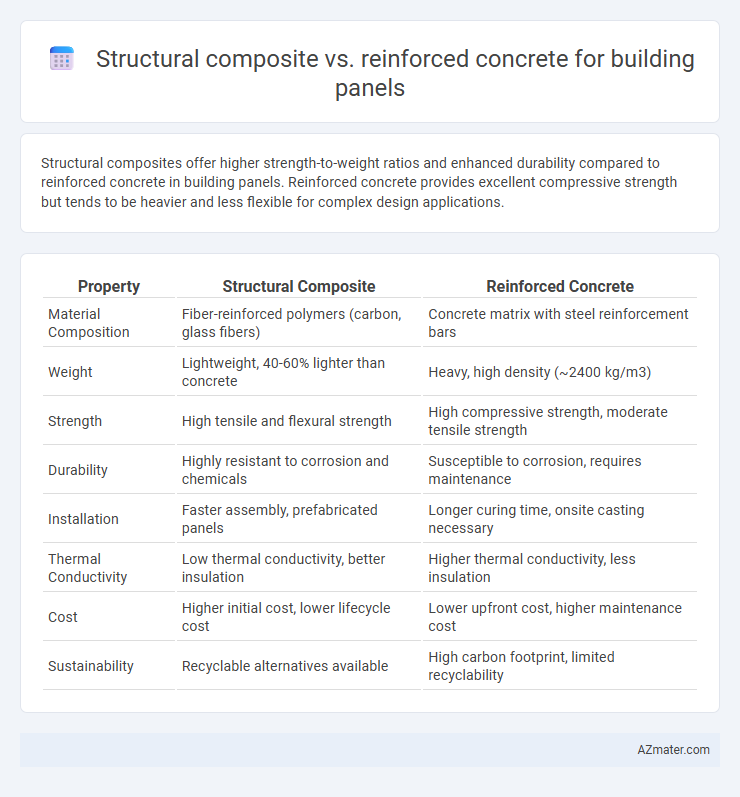Structural composites offer higher strength-to-weight ratios and enhanced durability compared to reinforced concrete in building panels. Reinforced concrete provides excellent compressive strength but tends to be heavier and less flexible for complex design applications.
Table of Comparison
| Property | Structural Composite | Reinforced Concrete |
|---|---|---|
| Material Composition | Fiber-reinforced polymers (carbon, glass fibers) | Concrete matrix with steel reinforcement bars |
| Weight | Lightweight, 40-60% lighter than concrete | Heavy, high density (~2400 kg/m3) |
| Strength | High tensile and flexural strength | High compressive strength, moderate tensile strength |
| Durability | Highly resistant to corrosion and chemicals | Susceptible to corrosion, requires maintenance |
| Installation | Faster assembly, prefabricated panels | Longer curing time, onsite casting necessary |
| Thermal Conductivity | Low thermal conductivity, better insulation | Higher thermal conductivity, less insulation |
| Cost | Higher initial cost, lower lifecycle cost | Lower upfront cost, higher maintenance cost |
| Sustainability | Recyclable alternatives available | High carbon footprint, limited recyclability |
Introduction to Building Panel Materials
Structural composites and reinforced concrete serve as essential building panel materials, each offering distinct performance advantages. Structural composites combine fibers and resin to yield lightweight, high-strength panels with excellent durability and corrosion resistance. Reinforced concrete integrates steel rebar within concrete to provide robust load-bearing capacity, fire resistance, and cost-effective construction for various structural applications.
Overview of Structural Composites
Structural composites for building panels consist of multiple materials engineered to combine strength, durability, and lightweight properties, often including fiber-reinforced polymers (FRP), laminated wood, and hybrid composites. These materials offer high strength-to-weight ratios, superior corrosion resistance, and design flexibility compared to reinforced concrete, which relies heavily on steel reinforcement embedded in cementitious material. Structural composites enhance thermal insulation and reduce construction time, making them ideal for innovative architectural applications and sustainable building solutions.
Fundamentals of Reinforced Concrete
Reinforced concrete utilizes steel bars or mesh embedded within concrete to enhance tensile strength, addressing concrete's inherent weakness under tension. Structural composites combine multiple materials with distinct properties to optimize performance, often resulting in lighter, more flexible panels compared to traditional reinforced concrete. The fundamental advantage of reinforced concrete lies in its ability to resist compressive and tensile forces simultaneously, making it a durable and widely used choice for building panels.
Material Properties Comparison
Structural composites offer superior strength-to-weight ratios compared to reinforced concrete, making them ideal for lightweight yet durable building panels. Reinforced concrete exhibits excellent compressive strength and fire resistance but tends to be heavier and more susceptible to cracking under tensile loads. The enhanced flexibility and corrosion resistance of structural composites contribute to longer service life and reduced maintenance in demanding construction environments.
Strength and Load-Bearing Capacity
Structural composite panels offer superior strength-to-weight ratios compared to reinforced concrete, enabling efficient load distribution without adding excessive weight. Reinforced concrete panels provide high compressive strength and excellent durability, making them ideal for heavy load-bearing applications in construction. While reinforced concrete excels in resisting compressive forces, structural composites deliver enhanced tensile strength and flexibility, optimizing overall structural performance.
Durability and Environmental Resistance
Structural composite building panels exhibit superior durability and environmental resistance compared to reinforced concrete, owing to their enhanced resistance to corrosion, moisture, and chemical exposure. Unlike reinforced concrete, which is prone to steel reinforcement corrosion and micro-cracking under freeze-thaw cycles, composites maintain integrity without significant degradation over time. This durability advantage results in longer service life and reduced maintenance costs, making structural composites a sustainable choice for harsh environmental conditions.
Weight and Installation Efficiency
Structural composite panels offer significantly lower weight compared to reinforced concrete, reducing transportation costs and easing handling during installation. Their prefabricated nature allows for faster on-site assembly, minimizing labor time and accelerating project timelines. Reinforced concrete panels, while durable, typically require heavy machinery for placement and longer curing times, impacting installation efficiency.
Cost Analysis and Lifecycle Assessment
Structural composite panels typically offer lower lifecycle costs compared to reinforced concrete due to their reduced weight, faster installation times, and decreased labor expenses, despite higher initial material costs. Reinforced concrete panels generally incur higher maintenance and repair costs over time, driven by susceptibility to cracking and corrosion, which affects long-term durability and structural performance. Cost analysis and lifecycle assessment reveal that structural composites provide better economic efficiency and sustainability in building panel applications by minimizing environmental impact and enhancing service life.
Sustainability and Environmental Impact
Structural composite panels, made from recycled materials like wood fibers and plastics, offer superior sustainability by reducing landfill waste and lowering carbon emissions during manufacturing compared to reinforced concrete. Reinforced concrete requires high-energy cement production, contributing significantly to CO2 emissions, whereas composites provide improved thermal insulation, lowering operational energy consumption in buildings. The lightweight nature of structural composites also reduces transportation energy and foundation requirements, enhancing overall environmental performance in construction projects.
Application Suitability and Selection Criteria
Structural composites offer superior strength-to-weight ratios and corrosion resistance, making them ideal for lightweight building panels in seismic or coastal regions. Reinforced concrete panels excel in applications requiring high compressive strength, fire resistance, and cost-effective mass production, suitable for foundations and load-bearing walls. Selection criteria hinge on factors such as environmental exposure, load requirements, thermal insulation, durability, and budget constraints, guiding the choice between advanced composites and traditional reinforced concrete.

Infographic: Structural composite vs Reinforced concrete for Building panel
 azmater.com
azmater.com